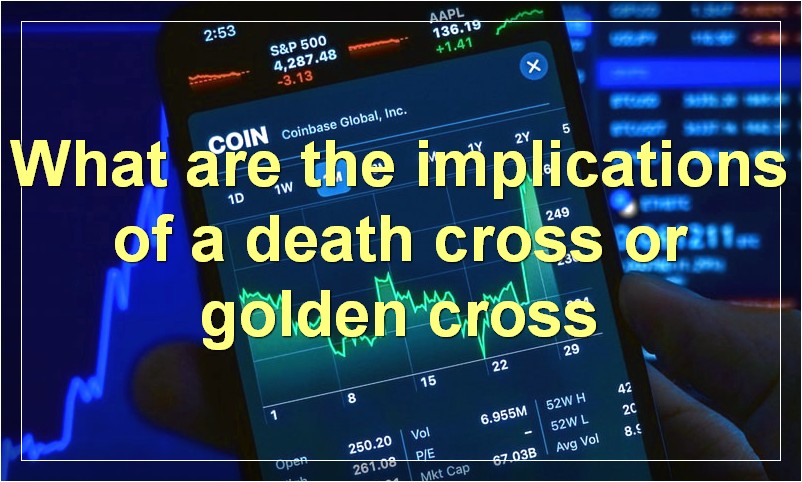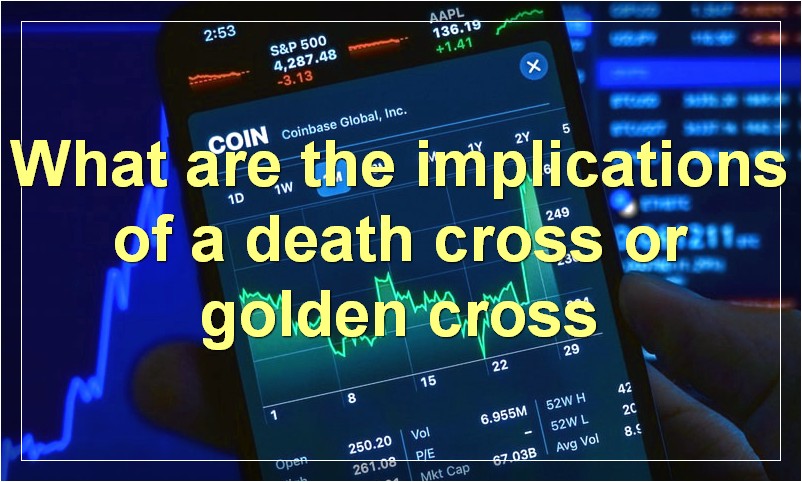When it comes to making investment decisions, some people rely on gut instinct while others follow a more systematic approach. But regardless of your method, understanding technical analysis is key to success. And when it comes to technical analysis, few concepts are more important than the Golden Cross and Death Cross.
What is the difference between a golden cross and a death cross
When it comes to technical analysis, there are a few key indicators that traders watch to get an idea of where the market is headed. Two of those indicators are the golden cross and the death cross. So, what is the difference between these two important signals?
The golden cross occurs when the 50-day moving average crosses above the 200-day moving average. This is generally seen as a bullish signal, as it indicates that the short-term trend is starting to turn up. The death cross, on the other hand, happens when the 50-day moving average crosses below the 200-day moving average. This is generally seen as a bearish signal, as it indicates that the short-term trend is starting to turn down.
One thing to keep in mind is that these signals are not always 100% accurate. There can be false positives and false negatives. However, they can be helpful in giving you an idea of where the market is headed in the short-term.
What are the implications of a golden cross or death cross

When a stock’s 50-day moving average crosses below its 200-day moving average, it’s called a “death cross.” This is generally seen as a bearish signal, as it indicates that the short-term trend is now down.
A “golden cross” occurs when the 50-day moving average crosses above the 200-day moving average. This is generally seen as a bullish signal, as it indicates that the long-term trend is now up.
So, what are the implications of a golden cross or death cross?
If you see a death cross, it may be time to sell your stocks, as the trend is now down. If you see a golden cross, it may be time to buy stocks, as the trend is now up.
What is the history of the golden cross and death cross
The golden cross and death cross are two technical indicators that are used by traders to signal a possible change in the direction of the market. The golden cross occurs when the 50-day moving average crosses above the 200-day moving average, while the death cross happens when the 50-day moving average falls below the 200-day moving average. Both patterns can be applied to any time frame, but they are most commonly used on daily charts.
The first recorded use of the golden cross was in April 1950, when it signaled the beginning of the long bull market that lasted until 1966. The death cross gained notoriety during the bear market of 2000-2002, when it correctly predicted the turn from an uptrend to a downtrend.
While the golden cross and death cross are both widely followed by traders, there is no guarantee that they will always signal a correct change in direction. As with all technical indicators, it is important to use them in conjunction with other forms of analysis before making any trading decisions.
How do analysts use golden crosses and death crosses
A golden cross is a bullish signal that is created when a short-term moving average crosses above a long-term moving average. This indicates that the short-term trend is now starting to move in the same direction as the long-term trend.
A death cross is a bearish signal that is created when a short-term moving average crosses below a long-term moving average. This indicates that the short-term trend is now starting to move in the opposite direction of the long-term trend.
What are some criticisms of using golden crosses and death crosses
The most common criticism of using golden crosses and death crosses is that they are lagging indicators. This means that they tend to give signals after the fact, which can make them less useful for traders looking to get ahead of a move. Other criticisms include the fact that these signals can be generated by false breakouts, and that they don’t always work in all market conditions.
Are there any other technical indicators that are similar to golden crosses or death crosses

The answer is yes, there are other technical indicators that are similar to golden crosses or death crosses. These include the moving average convergence divergence (MACD) indicator and the relative strength index (RSI). Both of these indicators can be used to identify potential trend reversals in the market.
How do you interpret a golden cross or death cross
When it comes to analyzing stock market trends, there are a variety of methods that investors employ. One such method is known as the “golden cross” or “death cross.” So, how do you interpret a golden cross or death cross?
Generally speaking, a golden cross indicates that a stock is in an uptrend, while a death cross indicates that a stock is in a downtrend. However, it’s important to note that these are just generalities and that there can be exceptions to the rule.
For example, let’s say that you’re looking at a chart of XYZ stock. The 50-day moving average is currently above the 200-day moving average. This would typically be considered a golden cross and would indicate that XYZ stock is in an uptrend.
Now, let’s say that you’re looking at the same chart of XYZ stock, but this time the 50-day moving average is below the 200-day moving average. This would typically be considered a death cross and would indicate that XYZ stock is in a downtrend.
Of course, it’s also important to consider other factors when making investment decisions. The golden cross or death cross may be a helpful indicator, but it’s not the only thing you should look at. Be sure to do your own research before making any investment decisions.
What are some trading strategies that use golden crosses or death crosses
There are a few different trading strategies that utilize golden crosses or death crosses. One strategy is to buy when the short-term moving average crosses above the long-term moving average, and to sell when the short-term moving average crosses below the long-term moving average. Another strategy is to buy when the 50-day moving average crosses above the 200-day moving average, and to sell when the 50-day moving average crosses below the 200-day moving average.
Some traders believe that golden crosses or death crosses can be used as leading indicators, while others believe that they are lagging indicators. No matter what your beliefs are, if you use either of these strategies, it is important to always use stop losses in order to protect your capital.
What are the risks associated with trading on a golden cross or death cross
When it comes to trading on a golden cross or death cross, there are a few risks that you should be aware of. First of all, if you’re not familiar with technical analysis, these terms may sound confusing and intimidating. But don’t worry – we’ll explain what they mean and how they can impact your trading.
A golden cross occurs when the 50-day moving average crosses above the 200-day moving average. This is generally seen as a bullish signal, as it indicates that the short-term trend is starting to turn up.
However, there are a few things to keep in mind before buying into a golden cross. First of all, it’s important to wait for confirmation – meaning that you should only buy after the 50-day moving average has actually crossed above the 200-day moving average. Secondly, keep in mind that this signal is more reliable in some markets than others. For example, it works better in stocks than in commodities.
A death cross occurs when the 50-day moving average crosses below the 200-day moving average. This is generally seen as a bearish signal, as it indicates that the short-term trend is starting to turn down.
Just like with a golden cross, there are a few things to keep in mind before selling into a death cross. First of all, again, you should wait for confirmation – meaning that you should only sell after the 50-day moving average has actually crossed below the 200-day moving average. Secondly, keep in mind that this signal is also more reliable in some markets than others. For example, it works better in stocks than in commodities.
So, those are the risks to keep in mind if you’re thinking about trading on a golden cross or death cross. Just remember to wait for confirmation and be aware of which markets these signals work best in.
What are some tax implications of golden crosses and death crosses
What are some tax implications of golden crosses and death crosses?
Golden crosses and death crosses are two technical indicators that can be used to predict future price movements in a security. A golden cross occurs when a security’s short-term moving average crosses above its long-term moving average, while a death cross occurs when the short-term moving average crosses below the long-term moving average. Both golden crosses and death crosses can have tax implications depending on how they are used. For example, if a trader buys a security when a golden cross occurs and then sells it when the security’s price rises, the trader may be subject to capital gains taxes. Similarly, if a trader buys a security when a death cross occurs and then sells it when the security’s price falls, the trader may be subject to capital losses taxes.

